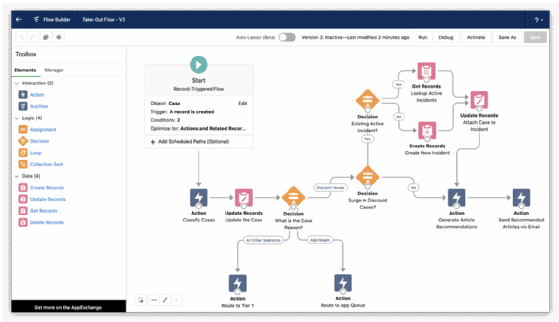
Getty Images/iStockphoto
Salesforce Service Cloud to add Servicetrace RPA, Slack
Salesforce plans to release features that increase Service Cloud's flexibility for contact centers to manage agents working remotely either part time or full time.
Salesforce Service Cloud users are about to get a peek at what's to come in the next year, and that includes features to help train and manage agents working from home, as well as to automate self-service workflows.
While few details were offered, Salesforce Service Cloud will add features from its acquisition of robotic process automation (RPA) vendor Servicetrace last month. That will help contact center agents -- who often have to switch among multiple applications in the course of solving customer problems -- work more efficiently, said Julian Armington, senior director of product marketing at Salesforce. It will also enable self-service with automated bot responses to customer questions.
Servicetrace is an API-based RPA technology as opposed to one that screen-scrapes keyboard strikes, mouse movements, and clicks, said Gartner analyst Jason Wong. It makes sense that Servicetrace will be paired with MuleSoft, Salesforce's API-based integration platform. How Salesforce deploys Servicetrace in 2022 will make a huge difference.
"That sounds great," Wong said. "When we get into the first iteration, what will it look like? Especially with the integration of acquired products like Slack and Servicetrace RPA, what it looks like is really important because the promise of going with single provider is more out-of-the-box ease of integration."
Coming in November
Salesforce Service Cloud will add Customer Service Incident Management and Omni-Channel Flow this November as part of the Winter '22 release. The former is a set of features that clusters related customer contacts together when a large event such as a power outage affects a group of customers and organizes a response across the service team.
Omni-Channel Flow integrates Salesforce's workflow platform into customer service scenarios. It can classify and route customer questions, call articles that may enable customers to solve problems themselves, and help connect agents with experts in their companies that can help address customer issues.
Eventually -- in the Spring '22 Salesforce release -- these flows also can trigger "swarming," which can assemble a team of agents with the right expertise to solve complex customer issues over Slack channels.
"We're really trying to enable the service employee to work on cases in their existing console, transition to collaborate with the rest of their organization within Slack, and still be able to bring all of that work back into Service Cloud and directly to customers," Armington said.

Next year's additions
Other features coming to Salesforce Service Cloud at various points in 2022 include Workforce Engagement Intraday Management, a staffing tool that enables companies to close the gap between forecasted work and actual needs.
Messaging for In-app & Web enables contact centers to maintain a persistent messaging experience from SMS, WhatsApp, a mobile application or a website, and pick the conversation up where it left off in Salesforce. This helps prevent dropped customer chats or forcing customers to repeat information.
Another feature, Einstein Conversation Mining, uses natural language processing (NLP) to monitor customer conversations across digital channels and the phone to continuously improve and optimize self-service channels and knowledge bases. This tool can help contact center leaders prioritize what frequent or otherwise time-consuming problems a service bot in development should solve first, or suggest a new article that addresses a frequent customer concern to which bots can refer customers to enable self-service.
Technologies like Einstein Conversation Mining are a logical extension of AI training improvement, Wong pointed out. Service bots first get trained with knowledge base articles and FAQs, but digital and NLP-transcribed human conversation can add a lot to the corpus of data from which self-service bots can draw.
"You're at a disadvantage if you're not continuously collecting the data, the conversations, the intents ... all the things that help to improve the overall data model and the AI algorithms," Wong said.
Salesforce discussed these coming Service Cloud features in advance of Dreamforce 2021, which takes place virtually Sept. 21-23.
Don Fluckinger covers enterprise content management, CRM, marketing automation, e-commerce, customer service and enabling technologies for TechTarget.







